Triple Crown
U.S. jewelry demand remains on an upswing for gold, silver and platinum thanks to such factors as softening prices, economic improvements, and aggressive marketing by industry groups and proactive brands.
The U.S. continues a slow, steady engine for jewelry demand, posting another small (2%) year-on-year increase,” cites the World Gold Council Q2 2015 report. Consumers were encouraged by lower prices, verified by an 11% year-on-year rise in gold jewelry imports for April and May. The rolling four-quarter total of U.S. jewelry demand reached 117.6t, its highest level since Q3 2011, as the market extended its uptrend. The slightly erratic nature of the economic recovery has proved a headwind to more convincing growth, but the WGC expects recovery in demand to gain momentum as yet lower prices feed through to consumers.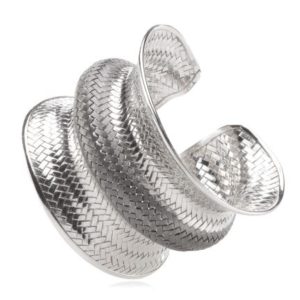
Moreover, the current silver boom is expected to continue for years to come, reports the Silver Promotion Service, with 90% of surveyed retailers high on silver. Despite the resurgence of gold with lower, more stable pricing, silver has become a must-have fine jewelry category. According to SPS, 67% of jewelers say their silver sales increased in 2014—with 48% reporting rises between 11% and 25%. Nearly half say silver experienced the best inventory turnover rate in 2014, and best margins for 43%. In fact, silver jewelry sales, as a percentage of overall jewelry sales, were on average 34% of unit and 30% of dollar volume. Year-over-year comparisons since 2008 show consistent data.
The market also is bullish on platinum, as U.S. jewelry sales for the metal rose for the second consecutive year, a trend expected to continue in 2015, cites the Platinum Guild International in its Retail Barometer. U.S. platinum jewelry sales rose 8% in volume in 2014, following an 11% year-over-year increase in 2013. Demand for platinum jewelry is expected to remain robust, growing more rapidly than the projected growth rate of total jewelry demand (7% versus 3%). In addition to declining unemployment, a strong stock market, and further improvement of consumer wealth, increased marketing by PGI and brands and a bridal emphasis benefit platinum sales. Since platinum isn’t mainstream in the U.S. yet, it’s in demand among millennials seeking unique jewelry, cites PGI.
Trending Styles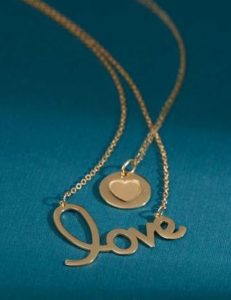
“Overall, there are style trends that carry across metals,” says Amanda Gizzi, director of public relations and special events for the Jewelers of America, citing things like lacey overlay, textures and details that give a three-dimensional treatment, openwork, repeating patterns, and fringe elements. In the spectrum of metals, she describes platinum as more classic, silver as more fashion-forward, and gold riding the fence between the two.
Gizzi sees the most design innovation happening in earrings and rings, with new takes like ear cuffs, climbers and jackets, and multi-finger, midi and cigar band rings. When it comes to classic staples, studs (especially new front to back styles), hoops, pendant necklaces (solitaire, charm), and bangles remain important—with layering the real trend in jewelry styling.
Gold Standard
As consumers returned to gold, demand has been strong for classics like studs, hoops and chains. “It has been six to seven years since the price of gold went sky high and the recession hit, and enough time has passed that consumers are revisiting the forever styles,” says Mark Hanna, CEO of the Richline Group, New York. “Now that it’s affordable again, consumers are back to gold jewelry they wear everyday.” But he cites collections that have a unique story/point of view as most successful like its teeny tiny collection of solid cast charm and pendant, necklaces that are “small in size but big in style” in iconic motifs. Michael Schechter, digital marketing/PR manager for Richline, notes that gold fashion has taken longer to resonate, but we’re now seeing a clear demand for it.
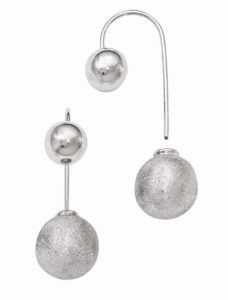 Fashion adores gold, prominent in many runway shows this fall including Dolce-Gabbana and Prada, says Cora-Lee Colaizzi, director of marketing and catalogs and senior merchandiser Quality Gold, Fairfield, Ohio. “The fashion industry is showing yellow metal and that will translate into continued interest at the jewelry counter.” Among Quality’s bestsellers have been 14K two-tone front-back earrings, textured bangles, and Y-drop and diamond-cut necklace styles.
Fashion adores gold, prominent in many runway shows this fall including Dolce-Gabbana and Prada, says Cora-Lee Colaizzi, director of marketing and catalogs and senior merchandiser Quality Gold, Fairfield, Ohio. “The fashion industry is showing yellow metal and that will translate into continued interest at the jewelry counter.” Among Quality’s bestsellers have been 14K two-tone front-back earrings, textured bangles, and Y-drop and diamond-cut necklace styles.
“One of the leading trends we’re also noticing is for gold chokers that open at the front, a nod to the ‘80s, but more delicate and sleek, less metal, more affordable, asymmetrical and often with gems at the ends,” tells Jamie Carwell Gage with lovegold.com, a digital platform to promote gold jewelry. “We’re also seeing bangles in this style, open and capped with gems or initials.”
Silver Streak
Silver has captured the fashion fine jewelry market, as designers regale in their ability to push boundaries and work in larger scale with an affordable yet precious metal. Designer Sara Blaine, a Benchmark partner based in Atlanta, Georgia hails it an easy color to wear. Silver has become a staple and will never go away as a fine jewelry category; it has its own strong fan base. My customers look to me for quality, good pricing and on trend designs that silver delivers.”
Silver is a wonderful opportunity for jewelers, hails Debra Puzio, executive creative director, for Ariva Living in Fine Jewelry, a Pranda 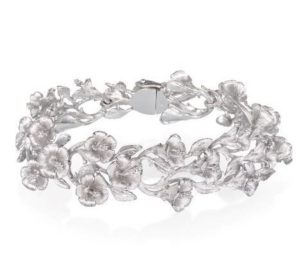 brand, Rhode Island. “Collections with a unique point of view attract silver lovers who are often self-purchasing females with discretionary income. The price of entry is affordable.”
brand, Rhode Island. “Collections with a unique point of view attract silver lovers who are often self-purchasing females with discretionary income. The price of entry is affordable.”
As silver grows in the jewelry market new designers have introduced innovative and unique textures and finishes like oxidized silver, which makes a beautiful backdrop for diamonds, says Isabel Cajulis, SPS project manager. “We’ve also seen organic textures inspired by vines, coral and other natural elements.” Puzio adds that silver styling in multiple color plating and finishing remains important and offers a point of interest when people browse silver collections.
Gone Platinum
The continued introduction of platinum jewelry at lower retail price points has helped to boost sales, as more brands introduce platinum products in both entry bridal and fashion designs. “Platinum allows designs to be intricate and innovative,” hails Amanda Tropila, public relations coordinator for the Platinum Guild International USA. “The metal’s properties give it the capacity to be crafted into delicate shapes, hold precious stones in place securely, and can be pulled into wires to make pieces that appear almost whimsical or fluid.”
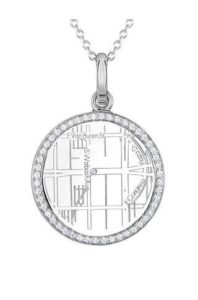 In bridal, classic looks like solitaires and halos (twist, double and triple) continue to be popular in platinum, Tropila cites. “Platinum is also branching out to make a bigger impact in “alternative” bridal looks this year with chunky, modern, super delicate or rough/raw styles. While platinum is often perceived as more traditional, this emergence into a different style of bridal jewelry is creating a new awareness for the metal of platinum as both fashionable and accessible.”
In bridal, classic looks like solitaires and halos (twist, double and triple) continue to be popular in platinum, Tropila cites. “Platinum is also branching out to make a bigger impact in “alternative” bridal looks this year with chunky, modern, super delicate or rough/raw styles. While platinum is often perceived as more traditional, this emergence into a different style of bridal jewelry is creating a new awareness for the metal of platinum as both fashionable and accessible.”
In fashion, Tropila cites staples and milestone/hallmark jewelry popular among consumers who want their classic pieces to last and capture special moments forever. “A. Jaffe’s Map Your Moment is available in platinum and serves as heirloom pieces to commemorate the spot of a special memory.” She emphasizes that the ounce price delta between platinum and gold is marginal; therefore, resulting in a smaller price differentiation at retail. “Platinum jewelry is available in a variety of prices and the availability of styles at entry levels points (starting at $1,000) has expanded as brands continue to explore design.”
Straddling the fence between bridal and fashion, stackable bands are widely popular in all metals, including platinum set with diamonds and precious stones, reports “Phyllis Bergman, CEO of Mercury Rings, a division of Interjewel Group, New York. “We’re doing really well with our platinum bands they’re great for bridal or fashion, anniversaries and other expressions of love.”
Pedal to the Metal
Storytelling is king when marketing jewelry overall, and the individual precious metals specifically. “In a world so communicative with social media, if you don’t have a story and can’t lend meaning to your products, you’re selling a naked commodity,” says Hanna, whose company started May is Gold Month 11 years ago to create a national dialogue around the gold mystique.
Bergman concurs that promoting the attributes of the various metals helps tell stories, noting that platinum, for example, is a unique metal for its purity, patina, luster, durability, and rarity. “You have a four-prong diamond solitaire ring, set it in platinum, and that becomes the story!” While Puzio notes that among silver’s claim to fame are scale and price: “Some of the best jewelry innovation of late has been routed in this noble metal.”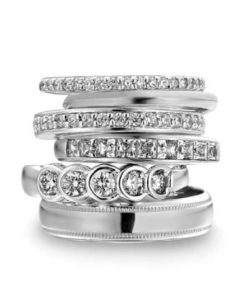
Gage advocates jewelers get in on the conversations by highlighting products they already have and new ways of thinking about them, like promoting the trend for layering. Show customers how to stack rings, wear multiple studs and hoops, and mix chain necklaces. “Go on social media and you’ll see in real time what people like and are responding to. It’s a platform to talk to your customers.”
Tropila reminds jewelers that they can’t sell what they don’t have. Consumers like to purchase what they can see and feel, or at least know they have options in metal choice that can be custom ordered.










